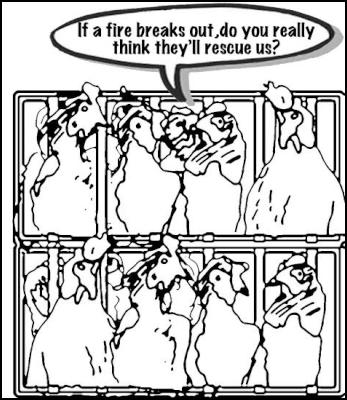Poultry Burning to Death? It's OK Says Big Agriculture
Poultry Burning to Death? It's OK Says Big Ag as it Shamelessly Fights Fire Safety
by Martha Rosenberg
February 18,
2014

There is a reason hospital burn units have the highest turnover of nurses. There is a reason the 1911 Triangle Shirtwaist fire in New York City and the 2012 Tazreen Fashions fire in Bangladesh live on in the world's consciousness. There is a reason hell is depicted as eternal fire. Perishing from a fire is an unfathomable death.
Yet millions of farm animals a year die in just this way--in preventable fires enabled by industrial scale, "factory" farming. Recent burn victims include 7,000 turkeys at a Butterball operation in North Carolina, 250,000 chickens at an Ohio Fresh Eggs, a Costco supplier and 500,000 chickens at Moark Hatcheries, a Walmart supplier in Colorado. These heartbreaking fires are underreported and news stories always say "no one was injured." What? After it allowed 250,000 birds to perish, Ohio Fresh Eggs even had the temerity to assure the public its “Easter egg donation project” would proceed as planned. A few hundred thousand burned hens would not affect the supply of cheap, plentiful eggs.
In 2012, the National Fire Protection Association (NFPA) addressed the sad and preventable scourge of farm fires by proposing an amendment requiring all newly-constructed farmed animal housing facilities to be equipped with sprinklers and smoke control systems. NFPA already requires sprinklers in facilities housing animals like bears and elephants that can't be easily moved. NFPA, established in 1896, is the "leading advocate of fire prevention" according to its website, dedicated to reducing "the worldwide burden of fire and other hazards on the quality of life by providing and advocating consensus codes and standards, research, training, and education."
Animals may not be human but they suffer in the same way said Joe Scibetta, a member of the NFPA Technical Committee which drafted the amendment. “When caught in a fire, animals don’t understand why they can’t breathe or why they are in such agony. They do, however, perceive and are conscious of the terrible sensations of burning, suffocation, and pain."
Scibetta also addressed the ethical responsibility of food producers. "In commercial animal housing facilities, when we confine animals to suit human purposes, we have an obligation to secure fire protection for them, especially due to the fact that in most of the recent . . . animal housing fire cases, humans were not on hand to effect rescue.”
But soon after the NFPA amendment, 15 Big Ag groups including the National Chicken Council, National Turkey Federation, United Egg Producers and cattle, pork and dairy producers appealed the NFPA proposal and it was scrapped. The reason? Animals' lives are not worth the cost says Big Ag.
A letter to NFPA from Michael Formica, chief environmental counsel for the National Pork Producers Council on behalf of the other Big Ag groups said that installing fire protection systems presented “staggering costs in the billions of dollars,” that many operations lack "sufficient water supply available to service an automated sprinkler system,” (let's situate our business where there's no water to put out fires!) and even that installing such systems and “the sprinkler water itself” would spread disease!
The maneuver was similar to a 2008 show of Big Ag force when the FDA tried to ban dosing of farm animals with cephalosporin antibiotics. It would be too expensive to farm without cephalosporins said Big Ag in unison and they won--the FDA backed down.
"While babbling that 'no one feels [the loss of their animals] due to accident, operational errors, disease or fire more acutely than' farmers do, in reality the animal farming industry prefers to let the trapped chickens, turkeys and other captive animals burn to death in agony and terror, and simply replace them and the buildings with insurance money plus taxpayer dollars funded through the US Department of Agriculture," says Dr. Karen Davis, president of United Poultry Concerns.
It is not even the "cost of doing business," said Davis in an interview, because the government and insurance pick up the cost of the animals allowed to burn to death. It is a win-win prospect for factory farmers.
Did Big Ag win this round, ensuring once again, cheap food at the cost of animal suffering? Not necessarily! Animals lovers, food activists and concerned consumers can post online comments about the NFPA animal housing fire proposal before May 16 and send written comments before April 11."It is an open consensus process," says NFPA. United Poultry Concerns has also placed a petition on Change.org. Most of the cruel conditions factory farms use to make cheap food are hidden from public view and animal decimating fires are a case in point.
ENDS


 Ramzy Baroud: Breaking The Silence On Palestinian Armed Struggle - A Call For Legal Clarity
Ramzy Baroud: Breaking The Silence On Palestinian Armed Struggle - A Call For Legal Clarity Adrian Maidment: Trump Tariffs Island Without People
Adrian Maidment: Trump Tariffs Island Without People Richard S. Ehrlich: The Dalai Lama's Escape & CIA Money
Richard S. Ehrlich: The Dalai Lama's Escape & CIA Money Binoy Kampmark: Addressing Hate Speech And Incitement - Holding Meta Accountable In Africa
Binoy Kampmark: Addressing Hate Speech And Incitement - Holding Meta Accountable In Africa Binoy Kampmark: Closed For Business - The Oddities Of Trump’s Tariffs
Binoy Kampmark: Closed For Business - The Oddities Of Trump’s Tariffs Martin LeFevre - Meditations: Teach Children The Distinction Between The World And Nature
Martin LeFevre - Meditations: Teach Children The Distinction Between The World And Nature